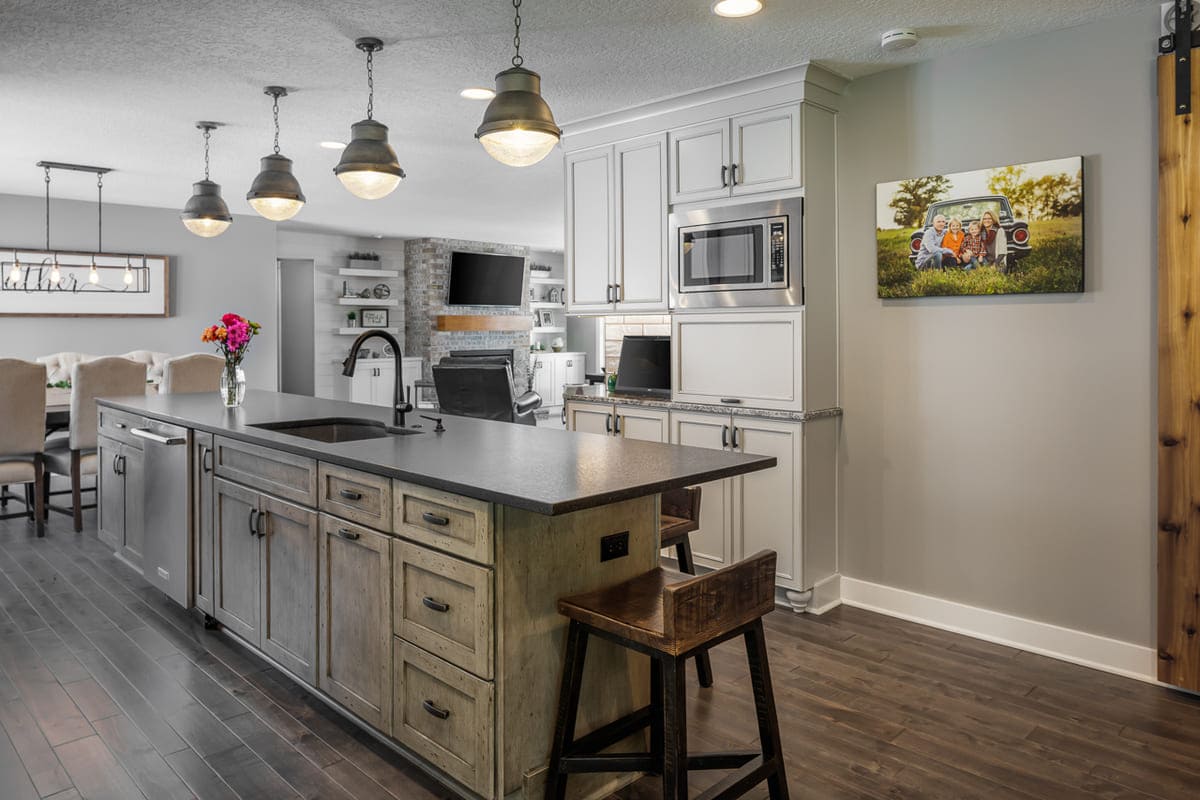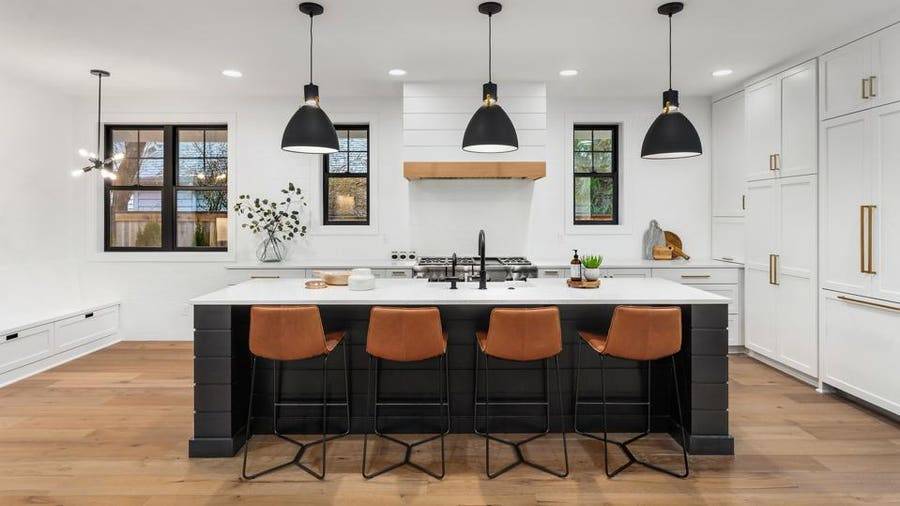Kitchen Remodel open wall to Dining Room, consider open walls to the dining room for a modern and spacious feel. This design allows for better interaction between the two spaces, creating a seamless flow for entertaining and family gatherings.
With an open wall, you can incorporate a breakfast bar or island, providing additional seating and serving as a focal point for both areas. Additionally, natural light can filter through the open space, brightening up the entire space. Whether you opt for a full open wall or a partial opening with a countertop overhang, this kitchen remodel idea can enhance the functionality and aesthetics of your home.
So, embrace the open wall concept and transform your kitchen and dining area into an inviting and stylish space.
Benefits Of Opening The Wall
When undertaking a kitchen remodel, one option that can transform the entire space is opening the wall to the dining room. This design choice offers a myriad of benefits that enhance both the aesthetics and functionality of your kitchen. By removing the barrier between the kitchen and dining room, you create an open and inviting atmosphere that can seamlessly integrate these two areas. Let’s explore some of the advantages that come with opening the wall.
Increased Natural Light And Better Views
One of the key benefits of opening the wall between your kitchen and dining room is the increased natural light that floods into the space. By eliminating a solid wall, you allow sunlight to flow through the windows in both areas, creating a brighter and more welcoming environment. Natural light not only adds warmth and beauty to the room but also makes it feel more spacious and inviting. Furthermore, by opening the wall, you can also enjoy better views of your dining room, allowing you to appreciate your decor and enjoy visual connections between the two spaces.
Improved Flow And Functionality In The Space
When you open the wall between the kitchen and dining room, you create a seamless transition that improves the flow and functionality of your space. With the barrier removed, you can easily move between the two areas, making meal preparation, serving, and cleanup a breeze. This open concept design also allows you to maximize storage and countertop space, as well as optimize the placement of appliances and fixtures. Whether you are hosting a dinner party or simply cooking a family meal, this improved flow and functionality ensure that everything is within reach and easily accessible.
Enhanced Social Interaction And Entertaining Opportunities
An open wall between the kitchen and dining room promotes enhanced social interaction and entertaining opportunities. Instead of feeling isolated while preparing meals, you can now engage with your family and guests while they relax in the dining room. This seamless connection fosters conversation and creates a more inclusive atmosphere, perfect for catching up with loved ones or entertaining friends. Whether you are hosting a festive gathering or enjoying a casual meal, the open wall design encourages interaction and creates memorable experiences for everyone.
Factors To Consider Before Starting The Project
Factors to Consider Before Starting the Project
Before embarking on a kitchen remodel with an open wall to the dining room, it is crucial to consider a few key factors that will determine the success of your project. Structural considerations and feasibility assessment, budget planning and cost estimation, as well as obtaining necessary permits and approvals are all essential aspects that need to be addressed before you begin. Let’s take a closer look at each of these factors.
H3: Structural Considerations and Feasibility Assessment
Before tearing down walls and creating an open concept between your kitchen and dining room, it’s crucial to assess the structural feasibility of your project. This involves taking into account the load-bearing capacity of the walls, as some walls may be supporting the weight of the upper levels of your home. In addition, evaluating the electrical, plumbing, and HVAC systems that might be running through the walls is important to ensure that the removal of the wall won’t compromise these essential elements.
To assess the structural feasibility, consider engaging the services of a qualified structural engineer or a knowledgeable contractor. They will be able to analyze the existing structural elements and provide insights on how to safely open up the wall while maintaining the integrity of your home’s structure. It is always better to be safe than sorry, especially when it comes to structural modifications.
H3: Budget Planning and Cost Estimation
Budget planning is a crucial step in any kitchen remodeling project. Opening up a wall to the dining room may involve various expenses such as labor costs, material costs, and the costs of any additional work that may arise during the process. It is essential to create a detailed budget that includes all these factors to avoid going overboard with your expenses.
Consider the following aspects when estimating costs:
– Labor costs: Depending on the complexity of the project, you may need to hire professionals such as contractors, carpenters, electricians, and plumbers. Research the local market rates for these services and factor them into your budget accordingly.
– Material costs: Assess the materials required for the project, including drywall, framing, flooring, and any additional finishes. Research the prices of these materials and determine which options provide the best balance between quality and cost.
By developing a comprehensive budget, you can avoid any financial surprises during the course of your project and ensure that you stay within your planned expenditure. Remember to keep a contingency fund for any unforeseen expenses that may arise.
H3: Obtaining Necessary Permits and Approvals
Any significant remodeling project, including opening up a wall between the kitchen and dining room, may require necessary permits and approvals from your local building authorities. Failure to obtain these permits can lead to legal complications and may negatively impact the future saleability of your home. Therefore, it is crucial to adhere to the legal requirements of your locality.
To determine whether permits are needed, contact your local building department or consult a professional who is knowledgeable about local regulations. They will guide you through the necessary paperwork, fees, and inspections to ensure that your project is compliant with building codes and regulations. By following the correct procedures, you can have peace of mind knowing that your kitchen remodel is not only aesthetically pleasing but also legally compliant.
In conclusion, when planning a kitchen remodel with an open wall to the dining room, it is essential to consider the structural feasibility, plan your budget carefully, and acquire the necessary permits and approvals. By addressing these factors before starting your project, you can ensure a smooth and successful kitchen remodel that seamlessly integrates your kitchen and dining area while minimizing any potential obstacles. Invest time in the planning phase to enjoy the rewards of a beautifully transformed space in the end.
Design Ideas For An Open Wall Kitchen Remodel
If you are considering a kitchen remodel and want to create a more open and connected space, removing the wall between your kitchen and dining room can be a game-changer. An open wall kitchen remodel not only enhances the overall functionality of your home but also creates a sense of openness that is perfect for entertaining guests and spending time with family. Here are some design ideas to help you make the most out of your open wall kitchen remodel.
Incorporating A Kitchen Island With A Breakfast Bar
One of the most popular design ideas for an open wall kitchen remodel is incorporating a kitchen island with a breakfast bar. This not only provides additional counter space and storage but also serves as a casual dining area for quick meals or a gathering spot for guests. The breakfast bar can be equipped with stools, allowing your family and friends to interact with you while you prepare meals. To make it even more functional and visually appealing, consider adding a sink or cooktop to your kitchen island.
Installing Sliding Or Folding Glass Doors For Seamless Integration
To seamlessly integrate your kitchen and dining room, consider installing sliding or folding glass doors. These doors not only bring in natural light but also create a visual connection between the two spaces. When open, they enable easy flow between the kitchen and dining room, making it convenient to serve meals or move between the two areas. When closed, the glass doors still maintain a sense of openness while providing privacy and noise reduction.
Creating A Cohesive Design With Consistent Materials And Color Palette
A cohesive design is key to a successful open wall kitchen remodel. To achieve this, it is essential to use consistent materials and a unified color palette throughout both your kitchen and dining room. This creates a seamless transition between the two spaces, making them feel like one cohesive unit. For example, you can choose the same type of flooring, cabinetry, and countertops for both areas. Additionally, selecting a consistent color palette that complements your overall home décor will tie everything together and create a visually harmonious space.
By incorporating a kitchen island with a breakfast bar, installing sliding or folding glass doors, and creating a cohesive design with consistent materials and a color palette, you can transform your kitchen and dining room into a stunning and functional space that enhances the overall flow of your home.
Hiring Professionals For The Remodel
Undertaking a kitchen remodel open wall to the dining room is a significant project that requires careful planning and execution. While you may be tempted to tackle the job yourself, hiring professionals for the remodel ensures a smooth and successful renovation. They bring a wealth of experience, industry knowledge, and expertise to the table, helping you achieve the kitchen of your dreams. In this section, we will discuss the key steps involved in hiring professionals for your kitchen remodel.
Finding Experienced Contractors Or Interior Designers
When it comes to finding experienced professionals for your kitchen remodel, it’s essential to conduct thorough research. Begin by searching online directories or platforms that specifically list contractors or interior designers specializing in kitchen renovations. Look for those with high ratings and positive customer reviews, indicating their reliability and craftsmanship. Additionally, seek recommendations from friends, family, or neighbors who have recently completed a similar project. Consider their firsthand experiences and insights as valuable information.
Requesting Quotes And Comparing Services
Once you have compiled a list of potential contractors or interior designers, it’s time to request quotes and compare services. Contact each professional individually, providing them with the necessary details of your kitchen remodel plans. Clearly outline your requirements, desired timeline, and budget constraints. As you receive quotes, carefully review each one, analyzing the breakdown of costs, materials, and labor involved. Pay attention to any additional services or warranties offered by the professionals. While cost is an important factor, remember to consider the overall value provided by each candidate.
Checking References And Previous Work Examples
Before finalizing your decision, it’s crucial to check references and review previous work examples of the professionals you are considering. By reaching out to their past clients, you can gain insight into their work ethic, communication skills, and ability to meet deadlines. This step helps you ensure that the professionals you hire align with your expectations and standards. Additionally, ask for before-and-after pictures or visit completed projects in person, if possible. This allows you to visualize the quality of their work and envision how they can transform your space.
In conclusion, hiring professionals for your kitchen remodel open wall to the dining room is a wise investment. By finding experienced contractors or interior designers, requesting quotes and comparing services, and checking references and previous work examples, you can make an informed decision and achieve beautiful results. So, take the time to research and select the right professionals for your project, and soon you’ll be enjoying a stunning and functional kitchen that seamlessly integrates with your dining room.
Steps To Take During The Remodel Process
When embarking on a kitchen remodel that involves opening the wall to the dining room, careful planning and execution are key. By following these essential steps, you can ensure a successful and seamless renovation that brings your dream kitchen and dining area to life. From removing the existing wall to installing necessary support beams and renovating both spaces simultaneously, each step is crucial in creating an open and inviting living space.
Removing The Existing Wall And Disposing Of Debris
Before any major changes can take place, the first step is to remove the existing wall that separates the kitchen and the dining room. This must be done carefully to minimize damage and ensure structural integrity. Hiring a professional contractor or a team of skilled tradespeople is highly recommended for this task.
Once the wall is taken down, it is important to dispose of the debris appropriately. Make sure to comply with local regulations and guidelines for construction waste disposal. This may involve contacting a waste management company or renting a dumpster specifically for the project. Maintaining a clean and safe work environment is essential throughout the remodel process.
Installing Necessary Support Beams Or Load-bearing Structures
With the wall removed, it is crucial to assess the structural requirements of the space. In some cases, the wall may have been load-bearing, meaning it provided support to the upper floors or roof of the house. To accommodate the open concept design, support beams or load-bearing structures must be installed in their place.
Consulting with a structural engineer or an experienced contractor is necessary to determine the appropriate size, type, and placement of the support beams. This step is essential for maintaining the structural integrity of your home and ensuring the safety of everyone in it.
Renovating The Kitchen And Dining Room Areas Simultaneously
Now that the wall has been removed and structural considerations have been addressed, it’s time to start the actual renovations. One advantage of opening the wall between the kitchen and dining room is the ability to renovate both spaces simultaneously, creating a cohesive and unified design.
Start by planning the layout and design for both areas, taking into account your specific needs and preferences. This may involve selecting new cabinetry, countertops, flooring, lighting fixtures, and appliances for the kitchen, as well as choosing furniture, lighting, and decor for the dining room. Consider factors such as functionality, aesthetic appeal, and budget throughout the decision-making process.
During the renovation, ensure that each element of the kitchen and dining room complements one another, creating a harmonious and stylish living space. Coordinate the installation of fixtures, appliances, and furniture in a way that maximizes efficiency while minimizing disruptions. Regularly communicate with your contractor or tradespeople to oversee the progress and address any concerns or changes that may arise.
By following these steps, you can confidently navigate the kitchen remodel process when opening the wall to the dining room. Remember to prioritize safety, seek professional expertise when necessary, and stay organized throughout the project. With careful planning and execution, your dream kitchen and dining area will become a reality, adding value and beauty to your home.

Credit: www.compellinghomes.com
Frequently Asked Questions For Kitchen Remodel Open Wall To Dining Room
Should I Open Up Wall Between Kitchen And Dining Room?
Yes, opening up the wall between the kitchen and dining room can create a more spacious and open layout for your home. It allows for easier flow between the two areas, making entertaining and family time more enjoyable. Consider consulting with a professional to ensure proper structural support and planning.
How Do I Open My Kitchen To My Dining Room?
To open your kitchen to the dining room, consider these steps:1. Knock down the wall between the two rooms to create an open concept layout. 2. Install a kitchen island or breakfast bar to separate the spaces while maintaining openness.
3. Choose matching or complementary colors and materials for a cohesive look. 4. Use lighting strategically to brighten both areas. 5. Add decorative elements like artwork or plants to enhance the connection between the two spaces.
How Do I Convert My Open Kitchen To Closed?
To convert an open kitchen to a closed one, you can install walls or partitions to create separate spaces. You may also consider adding doors or room dividers. Plan the layout, hire professionals, and obtain necessary permits before starting the renovation.
Can I Remove The Wall Between My Kitchen And Living Room?
Yes, you can remove the wall between your kitchen and living room. However, it is important to consult a professional contractor to determine if it is load-bearing and if any structural modifications are needed.
Conclusion
Opening up the wall between your kitchen and dining room can completely transform the space. The removal of the barrier allows for a more open and seamless flow, making both areas appear larger and brighter. With careful planning and design, this renovation can create a more functional and welcoming environment for cooking, dining, and entertaining.
Embrace the opportunity to reimagine your kitchen and dining room as one cohesive and inviting space.




